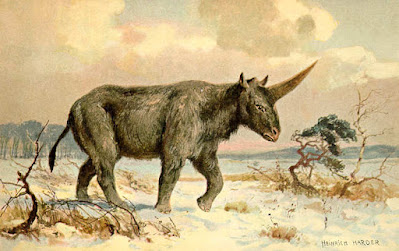WINGED WORDS WINDSDAY
Compiled by Rob Chappell (@RHCLambengolmo)
Vol. 1, No. 13: January 26, 2022
Celebrating Three Months of
#WingedWordsWindsday!
“The Many Faces of Mercury”
By Rob Chappell, M.A.
Adapted & Expanded from Cursus Honorum IX: 3 (October
2008
The planet Mercury
made headlines in 2008 when it was visited by NASA’s Messenger probe. Mercury is the smallest major planet in the Solar System; it is
also the closest planet to the Sun. It completes one orbit of our parent star
every 88 days, but it rotates on its axis every 59 days – so its “day” lasts
for two-thirds of its “year.” Because
Mercury has an extremely thin atmosphere, temperatures on its surface can vary
between 800 degrees Fahrenheit in the daytime to -300 degrees at night. Needless to say, life as we know it probably
doesn’t exist here.
This
enhanced photo of the planet Mercury was taken by NASA’s Messenger probe on January 14,
2008. (Photo Credit: NASA – Public Domain via Wikimedia Commons)
Astronomical
observations of Mercury are documented from the 14th century BCE onward.
Because Mercury always appears within 28 degrees of the Sun in our sky, it is
only visible to the naked eye either just before sunrise or just after sunset.
Whether known as Hermes (to the Greeks) or Mercury (to the Romans), the
innermost planet in our Solar System was named after the swift-footed messenger
of the Olympian pantheon because of its rapid movement through the sky. Mercury
was portrayed in art as wearing a pair of winged sandals and carrying a
caduceus (a wand with two serpents entwined around it).
“Or let my Lamp at midnight hour
Be seen in some high lonely Tower,
Where I may oft out-watch the Bear,
With Thrice-Great Hermes.”
à John Milton (1608-1674): “Il Penseroso”
Mercury ceased to be
worshiped in the Western world during late antiquity. However, the planet named
after him continued to be studied by medieval astronomers, who drew up
increasingly accurate tables of its motions in the sky. Starting in the 12th
century, debate ensued among astronomers as to whether Mercury orbited around
the Earth (as theorized by most Classical Greek astronomers) or around the Sun
(as proposed by a few late antique Roman writers).
Mercury’s name was
also given by the ancients to chemical element #80 – a liquid metal also known
as quicksilver or hydrargyrum. Discovered in early historic times, mercury was
believed to have both medical and metallurgical applications. Unfortunately,
liquid mercury is poisonous to humans if ingested, and that is what led to the
untimely demise of China’s first Emperor, Qin Shi Huang Dì (259-210 BCE): he
drank a mercury-and-jade potion that was supposed to have restored his lost
youth. In modern times, mercury has been used in thermometers, barometers, and
other scientific and medical instruments.
The
traditional symbol of the planet Mercury has been used since antiquity to
represent the chemical element mercury as well. (Image Credit: Public Domain
via Wikimedia Commons)
Perhaps Mercury’s
most enduring “face” has been that of the legendary Egyptian alchemist,
philosopher, and physician – Hermes Trismegistus (“Mercurius Termaximus in
Latin = “Thrice-Greatest Hermes or Mercury”). A collection of philosophical and
alchemical treatises began to circulate under his name during the first three
centuries CE in Alexandria, Egypt – produced by an interfaith group of scholars
and sages known as the Hermetic School. The Hermetic tractates preserved
Egyptian esoteric traditions about the origin of the cosmos and humankind’s
place within it. In these treatises, Hermes Trismegistus dialogues with his
disciples and encourages them to transmit his knowledge to posterity for the
benefit of humankind. After their translation into Latin by the Italian polymath
Marsilio Ficino (1433-1499), the Hermetic writings exercised a profound
influence upon the Renaissance intellectuals who spearheaded the scientific
revolution. Such scientific advancements were perhaps foreseen by one of the
Hermetic philosophers of ancient Egypt:
“[Humankind] will pursue the inmost secrets of Nature even into the
heights and will study the motions of the sky.
Nor is this enough; when nothing yet remains to be known than the
furthest boundary of the Earth, they will seek even there the last extremities
of night.”
à Heart of the
Cosmos (Hermetic Tractate, Early 1st Millennium CE)
Webliography
To learn more about
the many faces of Mercury, the Editor recommends the following resources.
·
https://messenger.jhuapl.edu/ = This is the official homepage of NASA’s Messenger mission to the planet Mercury.
·
https://www.sacred-texts.com/eso/pym/index.htm = The Divine Pymander of Hermes Trismegistus is the foundational text of the Hermetic
tradition.
·
http://www.webelements.com/mercury/ = Read all about Mercury (Hg), the 80th chemical element in the Periodic
Table.
Hermes
Trismegistus instructs his disciples in this Renaissance mosaic from the
cathedral in Siena, Italy. The tablet pictured at right contains a Latin
translation of a passage from the Hermetic writings. (Image Credit: Public Domain via Wikimedia
Commons)
“Hermes”
By Francis Thompson
(1853-1907)
Soothsay.
Behold, with rod two-serpented,
Hermes the
prophet, twining in one power
The woman
with the man. Upon his head
The cloudy
cap, wherewith he hath in dower
The cloud's
own virtue--change and counterchange,
To show in light,
and to withdraw in pall,
As mortal
eyes best bear. His lineage strange
From Zeus,
Truth's sire, and maiden May--the all-
Illusive
Nature. His fledged feet declare
That 'tis
the nether self transdeified,
And the
thrice-furnaced passions, which do bear
The poet
Olympusward. In him allied
Both parents
clasp; and from the womb of Nature
Stern Truth
takes flesh in shows of lovely feature.









